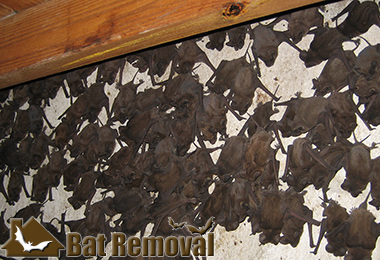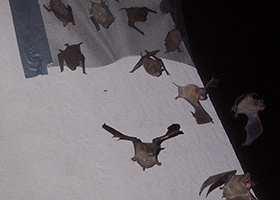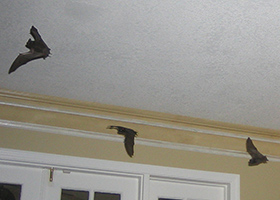Minneapolis Bat Removal
Welcome to Minneapolis Bat Removal! We are Minnesota bat removal specialists. It is important to know that bats are protected by Minnesota law, and are beneficial animals to have in the environment. We do not kill any bats during our bat removal process. Never hire a pest control company or anyone who says they are a Minneapolis bat exterminator. For correct and effective bat removal, you want a company that specializes in humane bat colony extraction. Our process is not only the only legal method in Minnesota, but it is the most effective. We have a 100% success rate in our bat control process. We perform our industry-best 32-point inspection of your house or building, and seal shut all bat entry holes down to 1/4 inch as part of the removal process, during which we remove the colony via special one-way exclusion devices specific to your architecture. Once all bats are safely out, we permanenetly bat-proof the structure. We also provide guano (bat droppings) removal and decon. Click on our Minneapolis Bat Control Prices page to find out more about our prices for bat control work. We work 24/7/365, and would love to talk to you about your bat problem. Call us any time at 612-284-0544 to discuss it, discuss our pricing, and if you wish, set up an appointment at your convenience, often same-day.

Minneapolis Building and Attic Inspections

No-kill Minnesota Bat Extraction

Guano Cleanouts - Serving all of Minnesota
Call 24/7 to discuss your bat problem.
Same-day or next-day appointments.
32-point inspection of your property.
Written estimates for bat removal project.
Fully state licensed and insured.
Residential and commercial service
100% no-kill Minneapolis bat extraction
Complete bat-proofing of your building
Compliance with all Minnesota, federal laws
Guano removal and attic decontamination
Our Service Range - 612-284-0544



Not All Bats Will Carry Rabies
While bats can deliver different benefits to our environment, the mainstream media has painted a bad picture out of the bats. They've exaggerated the health threats related with the bats and the damages that they can cause. The bats that you will encounter are usually healthy. In addition, the fact that they only come out at night will minimize the direct interaction between humans and bats.
Bats and Rabies: Debunking the Myth
One of the common health threats related with the bats would be rabies. This is a type of virus that attacks the nervous system of the host. It can be transferred through the scratches and bites of the infected creature.
Around 1 percent of the Bat Population is Infected with Rabies
The idea that majority of the bats are carrier of rabies is not true. This has been proven by a study that was published at the Journal of Wildlife Diseases. Most people who are working closely with the bats are aware of this fact. They have evidence to prove that bats are not ridden with pathogens and fungal spores. Based on the past studies around 10 percent of the bats that have been tested was determined positive with disease. The frequency will depend upon the species of bats and their level of exposure to humans. However, study conducted by the University of Calgary claimed that only 1 percent of the bat population is positive with the rabies virus.
Species of Bats That Are Possible Carrier of Rabies
The researchers decided to document the type of bats that the public are submitting for testing purposes. They also examined the carcasses of the dead bats to identify the presence of the rabies virus. Two of the species that they've tested are the Tree-Roosting Hoary and Silver-Haired Bat. These are the bats that are mostly killed by the wind turbines. They realized that these species are more likely to carry rabies than the other bats found in US.
The Research of the University of Calgary
The researchers conducted at the University of Calgary have submitted around 217 bat's carcasses at the USCDC (US Center of Disease Control and Prevention) to go through a series of testing. They've also completed a review of the literature related with the prevalence of rabies on bats that spans for 56 years. This include more than 65,000 bats. They found out that the numbers of infected bats are lower compared to what we thought.
Rabies can be transferred through bites and scratches in a manner that allows the rabies to be contained within the bat population. It will not be fast to eliminate the entire population and slow to kill the virus. Since only 1 percent of their population can carry rabies, public should concentrate more on the benefits that they can deliver to our environment rather than the health issues associated with them. Healthy bats will usually avoid humans. Those bats that will be fearless on the presence of humans are the possible carrier of the disease.

